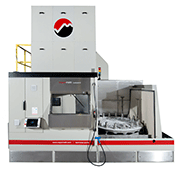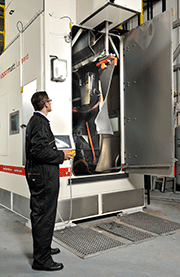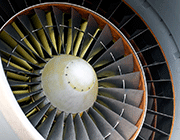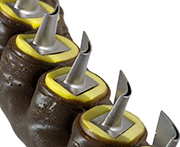E-Archive
Cover Page
in Vol. 16 - March Issue - Year 2015
Wet Blasting In The Aerospace Sector

Vapormatt Leopard 1

Vapormatt Leopard 2

Aircraft engine

Jig for peening turbine blades
The global Vapormatt Group was established in 1978 and the Head Office is based in Taunton, Somerset in the UK. The Company is owned by the third generation of the Ashworth family. As the originators of the pressure recirculatory wet blast process, the Ashworth family have accumulated experience and expertise in this field for over 50 years. The Company designs and manufactures manual and automatic surface cleaning, peening and finishing machines, using the Vapormatt Wet Blast and High Pressure Water Systems.
Versatility is the key for the wet-blasting process, which aerospace companies value when there is a requirement to process a wide range of components - from cleaning wheels to shot peening, explains Phil Dawes, Sales Engineer at Vapormatt.
A turbine blade's lifespan can be extended more than a thousand-fold by peening, which bombards its surface with small, hard particles. At the same time, aircraft wheels must be cleaned of surface dirt before being tested for cracks. These are just two of many industrial processes used in the aerospace industry. The surprise is that they can be achieved using the same technique: wet blasting.
Wet blasting uses a suspension of solid particles in a carrier liquid, most often water, to treat the surface of a material. The suspension, known as the 'slurry', is mixed with a pressurised gas, and forced through a nozzle and onto the material's surface. These different elements can be varied widely in order to have a particular effect. Heating the water and adding detergents and plastic 'scrubbing' particles makes it appropriate for cleaning; but ramping up nozzle pressure and incorporating harder particles like alumina or ceramics will prepare metal surfaces for processes like bonding - or even strengthen them, through peening.
It means that this single process can accomplish a wide variety of industrial tasks, from mild cleaning through surface grinding to shot peening. It is this enormous versatility, as well as its inherent safety - it creates no dust or statically charged parts - and enhanced surface, which are regarded as key benefits by the aerospace sector.
Abrasive performer
On first inspection, wet blasting looks like spraying a surface with dirty water. But careful choice of the abrasive particle, nozzle pressure, water temperature and other factors underpins a powerful, flexible technique that can be used in a range of applications across the aerospace industry, including:
Peening of turbine and fan blades
Preparation of surfaces for bonding and painting
Paint stripping - without substrate damage
Degreasing, de-rusting and descaling
General cleaning for overhaul and crack detection.
The choice of abrasive particle is critical. Fine particles will have a lesser effect than a larger particle. Aluminium oxide, for example, achieves a 'cutting' effect and creates a matt finish. A silicon glass bead gives a 'polished' finish, while ceramics, plastics and steel particles will have effects of their own. Many other media can be used, including bauxite, glass, ice, and even plum stones or walnut shells!
The liquid nature of wet blasting makes it highly versatile: altering the abrasive medium can change the process from one of cleaning to one of surface treatment. But the main advantage is undoubtedly its superior surface finish: the lubricating effect of wet blasting creates a flow of abrasive over the material, allowing more complex shapes to be processed, giving a surface that is more uniform and better prepared for coating, painting or bonding.
Some of its other advantages include: small footprint; low wear on parts; low breakdown of solid media; effective filtration and separation of abrasive particles; and, no need for pre-cleaning or degreasing.
Slurry composition is critical to the process. What comes out of a wet-blasting nozzle may appear unchanging, but underlying parameters can be altered and controlled to vary the process. The most advanced systems use software control to combine and monitor the flow of gas, air and solids.
The nature of the abrasive medium has the largest effect on the process. A tough particle like silicon nitride will have a very different effect to something soft like sodium bicarbonate. It is the shape, hardness and size of the particle that determines its abrasive effect.
But other factors will also alter the effect: the number (and nature) of nozzles will lead to widely varying effects - as will the angle at which they are deployed. Air pressure determines the speed at which the slurry shoots out of the nozzle, and the kinetic energy of the process. The acidity - or alkalinity - of the sump solution will determine its effectiveness in processes such as cleaning or rust inhibition.
By specifying and controlling these and other parameters, customers can get the exact effect that they need, from preparing a composite surface for bonding to deburring a mould tool. Today's most sophisticated wet blasting machines allow close control of media concentration, process temperature, additives and blast pressures for a consistent, reproducible surface finish that can be changed with relative ease - further enhancing wet blasting's versatility.
Large and small components
In a further illustration of wet blasting's versatility, component size is not a limiting factor - as it can be used for everything from nuts and bolts to wing spars. It is common for small and large parts to receive identical treatment: tiny fixings may undergo the same surface treatment as a large forging, especially if the parts are later attached together. But this 'identical treatment' can be achieved in different ways. Small fixings, for example, would be treated in bulk in a tumbling barrel. But a part like a wing spar would be set up in a large chamber, and then blasted by robotic or servo-controlled nozzles moving across its surface.
Traditionally, this was a manual process: an operator in a protective suit would pick up the blasting gun and treat the entire surface of the part. Some processes, such as cleaning aircraft wheels to test for underlying cracks, are still done manually. But automation has become far more prevalent in wet blasting, as it has for many other industrial processes.
For large parts like wing spars, automation ensures consistency. In highly regulated industries like the aerospace one, the quality of each part needs to be identical. This is achieved by treating each one in exactly the same way, with no variation.
A good example is when treating the surface of an aerofoil, allowing a de-icing strip to be glued to it. Automated wet blasting ensures consistent surface cleaning, which guarantees an identical bond every time.
For small parts, the main advantage of automation is to save time and money, as treating many separate parts by hand can prove impossibly costly.
Monitor and control
There are around 15 parameters to control in wet blasting, making it far from straightforward. But Vapormatt believes that as long as they can be measured, they can be controlled. A circuit diagram of the process shows the various parameters that must be controlled. They include:
Pressure and volume of air
Slurry pressure
Water temperature, pH and conductivity
Filtration, rinsing, drying
Gun (nozzle) angle, range and speed
And it's not enough simply to measure these levels. The process must also be controlled automatically - and one of the most important measurements to make concerns particulate levels in the slurry.
As the abrasive particles begin to break down during wet blasting the process starts to lose its effectiveness. The answer is to add more abrasive particles to the slurry, but this must be done in the correct proportion and at the same rate at which the existing particles are breaking down. This is especially important in critical processes like peening.
The concentration of abrasive particles needs to be 15-20% by weight (and, in some cases, up to 50%). Maintaining this relies on close control of the process. Vapormatt does it in a very elegant way, using its patented elutriation towers. These work on the principle of Stokes' Law, which states that the rate of fall of a particle through a fluid is related to its size and density. So, as the slurry is recycled, it is fed into a column of water that is pumped upwards: heavier particles fall quickly to the bottom, while lighter ones remain at the top and are removed. By using elutriation towers, very fine medias can be used with some machine designed to blast with a 500-mesh setting where the particles can be as small as 25 microns.
The second stage of this process is to measure how many 'good' particles are left. This is done by constant monitoring of slurry density with a flow meter. By detecting when too many particles have broken down, new particles can be added automatically.
Wheel cleaning, shot peening
The aerospace industry uses wet blasting for a diversity of operations. A whole series of aerospace industry processes can be achieved through this single technique.
At one end, there is cleaning. When aircraft tyres are changed, the wheels are inspected for cracks via non-destructive testing. First, the surface grime is removed using wet blasting at a pressure low enough to remove dirt but not affect the paint layer. The technique has many other uses in the industry, such as removing paint, preparing composites and degreasing. But by far the most robust technique is peening, which is used to condition the surface of critical parts like turbine blades. It puts the surface under compression to make it resistant to cracking, and extends service life by more than a thousand times.
Peening is traditionally performed by dry blasting, which hits the surface with great force. But wet blasting has its benefits: it produces a far smoother surface and is unlikely to introduce surface contamination from media impingement - hich is where cracks can start. One leading aerospace manufacturer recently began using Vapormatt's wet-peening process for this very reason. The switch made economic sense, as the company already uses wet blasting for many other operations.
And this, ultimately, is its greatest advantage: by investing in one innovative, flexible technique, aerospace companies can perform many separate industrial operations - which might otherwise have required investment in several different technologies.
For Information:
Vapormatt
Monarch Centre, Venture Way
Priorswood Industrial Est., Taunton
Somerset, TA2 8DE, England
Tel. +44.1823.257976
E-mail: sales@vapormatt.com
www.vapormatt.com



























